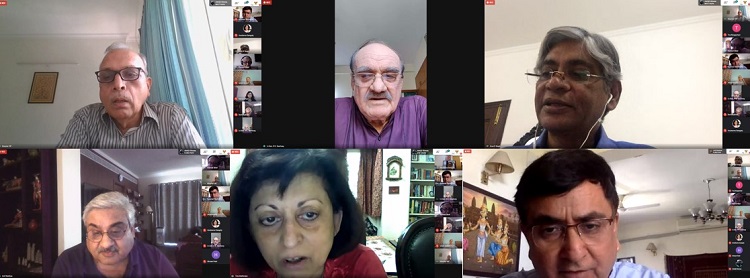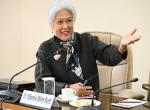The European Union (EU) has faced a series of crises in the last decade which have tested its resilience as a supranational entity based on solidarity and common values. Since several of its internal issues remain unresolved, the EU would now have to deal with them amid new disruptions brought upon by the coronavirus disease (COVID-19). The EU’s handling of the ongoing pandemic has already been under the scanner owing to its failure to come up with a concerted action in the initial stage of the COVID-19 outbreak. To discuss EU’s trajectory in light of these new challenges as well as to deliberate upon the future of its relationship with India, the Vivekananda International Foundation (VIF) organised a virtual brainstorming session on 22 May. The session was led by VIF Director, Dr. Arvind Gupta who delivered the opening remarks. This was followed with presentations by Amb. Kanwal Sibal, Amb, TCA Rangachari, Amb. Arun K. Singh, Amb. Anil Wadhwa, Professor Gulshan Sachdeva, Lt. General Ravi Sawhney and Amb. Bhaswati Mukherjee.

The EU was preoccupied with Brexit and the renewed refugee influx via the Mediterranean when it was caught almost off-guard by the outbreak of COVID-19 in Italy. The initial response was spearheaded by member countries which aimed at shielding one’s own country from the contagion given the nature of its open borders and free movement. However, the existing supranational mechanism within the EU meant that a decision by any one country was bound to inevitably impact others. As was evident in the days to follow, a pan-EU response failed to materialise. On the face of it, the domestic responses were understandable given their sole purview in health policy of their state. However, what stood out was that those decisions were taken without any consultations with the EU leadership, thereby going against the Commission’s stance and principles of European solidarity. The lack of a concerted action at the time left the impression that the EU had deserted Italy “in its hour of need”. As the virus spread to other member states, the divide only became stronger. While the EU soon began to pull its act together by reprimanding the inward approach of member states announcing relief packages and, disagreements among member states with respect to the future course of actions have stood out during negotiations.
In light of these developments, there are several palpable trends shaping the post COVID-19 EU, as observed by the participants:
First, the Schengen or the free movement arrangement within the EU has suffered a blow and has exposed the fault lines within the EU. Even though the return to status quo is expected as soon as virus subsides, the gravity of this disruption would depend upon the second wave of coronavirus outbreak and ensuing border controls. These border restrictions are likely to have adverse impact on seasonal migrants from Eastern Europe.
Second, it is evident European countries found it hard to deal with the coronavirus pandemic despite their advanced healthcare system. The high death toll in the European countries reflects of the ageing demographic profile of the continent. A diminishing host population combined with rising unemployment may have further implications on migrants or ‘outsiders’ in general. In addition to this, the present disruptions may have major implications for skilled migrants from Asian countries. The coming years may see easier migration rules for selected sectors like healthcare but greater regulation in other sectors. Since security of supply chains is expected to take precedence over globalisation and lower cost of production in the post COVID-19 scenario, it may also prompt withdrawal from some offshore production.
Third, the old and new Europe divisions are manifesting themselves yet gain. Internal differences arising from different levels of economic prosperity as well as differing threat perceptions have reinforced the North-South and East-West divide. These divisions not only make it difficult to reach a consensus on an economic package but also with respect to engagement with countries like China and Russia. These trends run parallel to a waning relationship with the United States.
A related trend is with respect to the revival of the Franco-German ‘motor’. The joint call for a European recovery proposal by France and Germany in this respect also gains relevance in terms of ensuring solidarity in a post Brexit EU.
So far as the relations with India are concerned, a dynamic India-EU partnership rests on a renewed enthusiasm on both sides. A key determinant for India in this regard would be the extent to which this partnership helps in fulfilling its goal of ‘atmanirbharta’ or ‘self-reliance’. There is ample scope for cooperation given their converging interests and shared values, but requires a fresh streamlining of ideas. Since it is clear that both the sides lack the political appetite to deal with the free trade agreement at the moment, there is a need to identify a new narrative that goes beyond the stalled trade deal. Thus, it would be prudent to focus more on other viable areas like health, research and education, environment including climate change and cybersecurity, etc, which elicit mutual benefits. As the two sides plan to go ahead with the postponed summit in the coming months, the need for a deep dialogue in these lines has to be envisioned.
To conclude, the EU has weathered several serious crises in the last decade. Although it found it difficult to a coordinated response in the initial stage of the pandemic, the EU is trying hard to uphold its cherished solidarity. The situation has largely stabilised within the EU, but the region is still not virus free. In the absence of a vaccine, the possibility of a second wave also remains high. In this context, the manner in which the EU responds to the upcoming socio-political and economic challenges would also determine its partnership with other countries, including India.











Post new comment